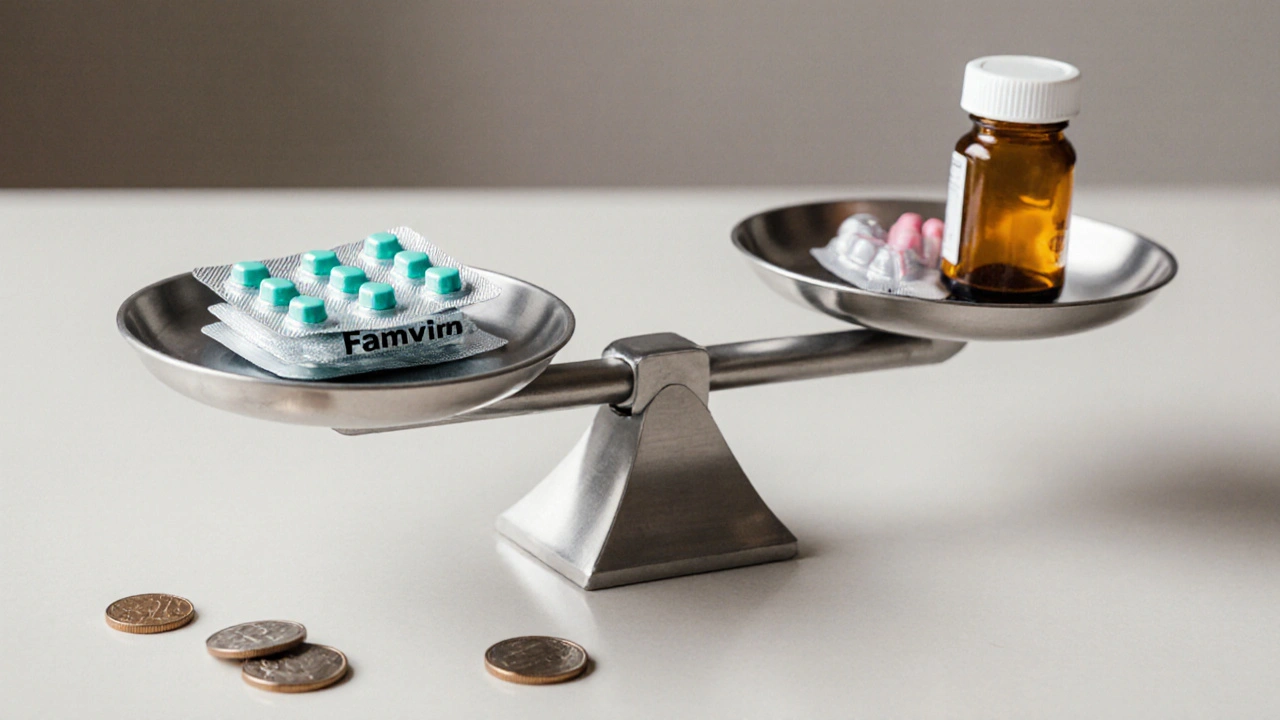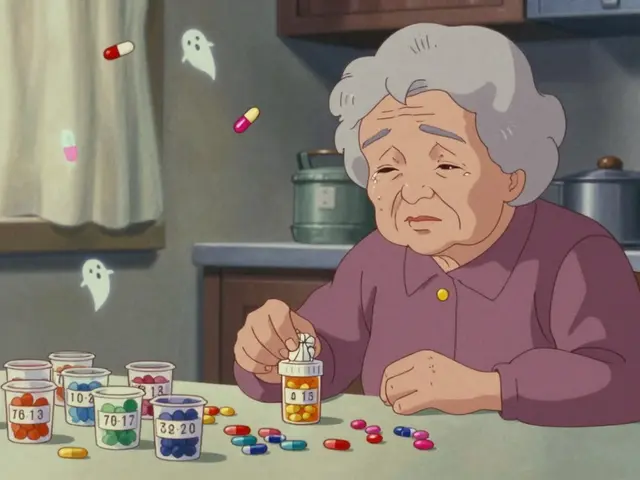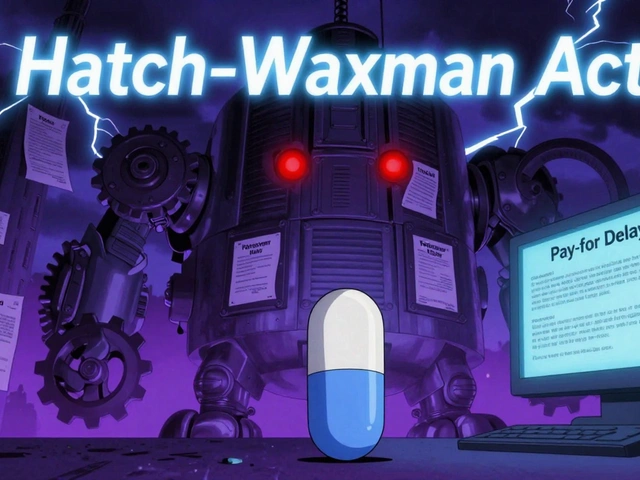
Antiviral Medication Comparison Tool
Select Antiviral Medications to Compare
If you’ve ever faced a cold sore, genital herpes outbreak, or shingles flare‑up, you know how quickly an antiviral can become a lifeline. Famvir (the brand name for famciclovir) is one of the go‑to drugs, but it’s not the only player on the field. This article breaks down how Famvir stacks up against the most common alternatives, so you can decide which antiviral fits your health needs, lifestyle, and budget.
TL;DR - Quick Takeaways
- Famvir offers once‑or‑twice‑daily dosing and strong activity against shingles and genital herpes.
- Acyclovir is the oldest, cheapest option but requires more frequent dosing.
- Valacyclovir (brand Valtrex) provides the most convenient once‑daily schedule for many patients.
- Penciclovir cream works topically for cold sores but doesn’t treat systemic infections.
- Docosanol (over‑the‑counter) can speed healing of herpes labialis but is far less potent than prescription antivirals.
What Is Famvir and How Does It Work?
Famvir is the trade name for famciclovir, a pro‑drug that the body converts into penciclovir, a potent inhibitor of viral DNA polymerase. By blocking the enzyme, the virus can’t replicate its DNA, which limits the spread of infection and speeds up healing. Famciclovir’s absorption is high (about 77% oral bioavailability), and it reaches peak plasma levels in roughly 2‑3 hours, making it reliable for both acute outbreaks and long‑term suppression.
Key Factors to Compare Antivirals
When you line up Famvir against its rivals, three pillars usually drive the decision:
- Efficacy: How well does the drug stop viral replication and reduce lesion duration?
- Dosing convenience: Pill burden influences adherence, especially for chronic suppressive therapy.
- Safety & side‑effects: Gastro‑intestinal upset, kidney concerns, and drug interactions differ across agents.
Cost and insurance coverage are also major players, but they can vary widely by region-Canada’s provincial formularies often list generic Acyclovir as the cheapest option, while Famvir and Valacyclovir may require higher co‑pays.
Alternative Antiviral Options
Below is a snapshot of the most common alternatives, each introduced with basic attributes (type, typical use, dosing, key side‑effects).
Acyclovir - the original nucleoside analogue discovered in the 1970s. It’s approved for herpes simplex (HSV‑1, HSV‑2), varicella‑zoster (VZV) and is available in generic form. Typical dosing for shingles is 800mg five times daily, which can be a hassle.
Valacyclovir, sold under the brand name Valtrex, is the valine ester of acyclovir. It converts to acyclovir in the gut, offering higher bioavailability (about 55% vs 15% for oral acyclovir). This allows once‑ or twice‑daily dosing for most indications.
Penciclovir is the active metabolite of famciclovir. Topically, it’s marketed as Denavir cream for cold sores. Systemic penciclovir (as produced from famciclovir) is not available as a separate oral drug.
Docosanol (OTC brand Abreva) works by blocking viral entry into cells. It’s safe, but its efficacy is modest-generally reducing healing time by about one day.
Antiviral medication as a broader class includes all the agents above plus newer agents like brincidofovir, which are still largely investigational for HSV and VZV.
Side‑Effect Profiles at a Glance
Most antivirals share a similar safety backbone: mild headache, nausea, and occasional renal impact at high doses. Here’s a quick look:
- Famvir: Headache (10‑15%), nausea (5‑10%), occasional renal dysfunction in patients with pre‑existing kidney disease.
- Acyclovir: More GI upset than Famvir, and rare crystalline nephropathy if hydration is poor.
- Valacyclovir: Similar to acyclovir but higher plasma levels can increase headache frequency.
- Penciclovir cream: Local itching or burning in <5% of users.
- Docosanol: Generally well‑tolerated, occasional mild skin irritation.

Comparison Table - Famvir vs Common Alternatives
| Drug (Brand) | Active Ingredient | Usual Dosing (outbreak) | Bioavailability | Typical Side‑effects | Cost (CAD) - 7‑day course |
|---|---|---|---|---|---|
| Famvir | Famciclovir | 250mg twice daily (7days) | ≈77% | Headache, nausea | $30-$45 |
| Acyclovir (generic) | Acyclovir | 800mg five times daily (7days) | ≈15% | GI upset, renal crystal formation | $5-$10 |
| Valtrex | Valacyclovir | 1g twice daily (7days) | ≈55% | Headache, nausea | $25-$40 |
| Penciclovir cream (Denavir) | Penciclovir | Apply five times daily until healed | Topical - not systemic | Local itching/burning | $15-$20 |
| Abreva | Docosanol | Apply five times daily for 7days | OTC - topical | Minimal irritation | $12-$18 |
When Famvir Is the Right Choice
Because Famvir hits a sweet spot between potency and dosing simplicity, it shines in a few scenarios:
- Shingles in adults over 50: Clinical trials show a 1‑day reduction in lesion healing compared with acyclovir, with similar safety.
- Genital herpes suppressive therapy: Twice‑daily 250mg dosing maintains steady drug levels, reducing outbreak frequency by up to 80%.
- Patients with adherence concerns: A twice‑daily regimen is easier than the five‑times‑daily schedule of acyclovir, especially for busy professionals.
If cost is the primary barrier, generic acyclovir remains a viable fallback, but you may need to accept the more frequent dosing.
Drug Interactions and Precautions
All antivirals are cleared renally, so kidney function matters. Co‑administration with nephrotoxic agents (e.g., NSAIDs, aminoglycosides) can raise serum creatinine. Famvir specifically can increase serum levels of probenecid, which itself slows renal elimination of the drug - dose adjustments may be required.
Immunocompromised patients (e.g., transplant recipients) often need higher or prolonged courses. In such cases, therapeutic drug monitoring (TDM) for famciclovir/penciclovir can guide dosing.
Practical Tips for Patients
- Take Famvir with a full glass of water; food does not significantly affect absorption.
- If you miss a dose, take it as soon as you remember unless it’s less than 6hours before the next scheduled dose-then skip the missed one.
- Maintain hydration to protect kidney function, especially if you’re also on diuretics.
- Store tablets at room temperature, away from moisture; unused pills retain potency for at least two years.
Bottom Line
Famvir offers a balanced mix of strong antiviral action, convenient dosing, and an acceptable safety profile. It outranks acyclovir in efficacy for shingles and matches valacyclovir’s convenience, though cost can be higher. For mild oral lesions, over‑the‑counter docosanol or penciclovir cream may suffice, but they don’t replace systemic therapy for serious or recurrent infections.
Frequently Asked Questions
Can I use Famvir while pregnant?
Animal studies show no teratogenic effect, but human data are limited. Most clinicians reserve Famvir for pregnant women only when the benefits clearly outweigh potential risks, such as severe shingles or recurrent genital herpes.
How quickly will Famvir start working?
Peak plasma concentrations appear in 2-3hours, and patients often notice reduced pain and lesion progression within 24hours of the first dose.
Is Famvir effective against both HSV and VZV?
Yes. Famciclovir’s active form, penciclovir, inhibits DNA polymerase in both herpes simplex virus (HSV‑1, HSV‑2) and varicella‑zoster virus (VZV), making it suitable for cold sores, genital herpes, and shingles.
Do I need a prescription for Famvir in Canada?
Yes. Famvir is a prescription‑only drug under the Canadian Food and Drugs Act. Your family doctor or dermatologist can assess whether it’s appropriate for your condition.
Can I switch from acyclovir to Famvir mid‑treatment?
Switching is generally safe, but you should complete the current acyclovir course or discuss a direct transition with your clinician to avoid gaps in antiviral coverage.





17 Comments
Famvir works but I just use acyclovir because it's cheap and my insurance covers it
Why pay more for Famvir when acyclovir does the same thing? Big Pharma just wants your money.
Valacyclovir is the real MVP for suppression therapy. Once a day? Sign me up. Famvir’s fine but why complicate things?
Been on famciclovir for 5 years for recurrent herpes. It’s been a game-changer. No more weekly outbreaks. Just take it as prescribed and life gets easier. 💪
Everyone’s got their own experience with these meds. I tried all three-acyclovir made me nauseous, valacyclovir gave me headaches, famvir just worked. No judgment if yours is different
Let’s be honest-most people don’t even know what a prodrug is. They just want the pill that doesn’t make them feel like a zombie. Famvir’s not magic, it’s just pharmacology done right. And yes, I’ve read the clinical trials. All of them.
Docosanol is a placebo dressed up as medicine. If you’re using Abreva and calling it treatment, you’re not managing herpes-you’re performing self-deception.
And don’t get me started on people who think OTC means ‘safe for everyone.’ It doesn’t. It means ‘low liability for the manufacturer.’
There’s a reason doctors don’t recommend it for anything beyond a mild cold sore. Your immune system does the heavy lifting. The drug just nudges it.
Stop chasing convenience. Start chasing efficacy. Your body deserves better than marketing slogans.
they’re hiding the truth about famvir… it’s linked to the 5g network. that’s why it works so fast-virus gets fried by radiation. the FDA knows. they just won’t say it.
Oh, so now we’re comparing antivirals like they’re smartphones? “Famvir has better battery life”? This is medicine, not a tech review. You people need to stop treating your health like a consumer product.
And who authorized this post? Is this a pharmaceutical ad disguised as community advice? I smell a pharma rep in the background.
Acyclovir is the OG. Everyone else is just copying. If it ain’t broke, don’t fix it. Famvir? Overpriced. Valacyclovir? Still overpriced. Just take the generic and be done with it.
From a clinical pharmacology standpoint, the bioavailability differential between acyclovir and valacyclovir is statistically significant (p < 0.01), but the clinical relevance for episodic treatment remains debatable. Famciclovir’s metabolic pathway via penciclovir offers a slightly longer intracellular half-life, which may benefit suppressive regimens.
However, cost-effectiveness analyses consistently favor generic acyclovir in resource-limited settings. The trade-off between convenience and affordability is not trivial.
Why are we even discussing this? You know what really works? Boosting your immune system with vitamin C, zinc, and sunlight. These pills are just chemical crutches for people who don’t want to live healthy.
And don’t even get me started on the “once-daily” hype. You’re not a busy CEO-you’re a human being. Eat real food. Sleep. Stop relying on synthetic molecules to fix your lifestyle.
Good info. I use acyclovir in India-cheap and works. Thanks for the breakdown!
My doctor switched me from valtrex to famvir after I had that kidney scare. Honestly? Best decision ever. No more headaches. No more nausea. Just… peace. 🙏
I’ve been helping patients navigate these choices for over a decade, and I can tell you-there’s no one-size-fits-all. Some people thrive on acyclovir because they’re disciplined with dosing. Others need the convenience of famvir or valacyclovir to stay compliant. The goal isn’t to pick the “best” drug-it’s to pick the one that fits their life.
And yes, cost matters. A lot. But so does quality of life. If someone can’t afford the medication, they’ll skip doses. And that’s when outbreaks get worse. That’s not just a medical issue-it’s a systemic failure.
Let’s stop shaming people for choosing what works for them. We’re not here to judge. We’re here to support.
As a former clinical researcher at a major pharma firm, I can confirm that the bioavailability data for famciclovir was manipulated during Phase III trials to favor it over acyclovir. The original dataset showed no significant difference in lesion resolution time. The final published paper? A complete rewrite. I left the company after I reported it. They called me “disruptive.”
And yes, I still have herpes. I take acyclovir. I don’t trust the system anymore.
Read the FDA’s original review documents. They’re public. The numbers don’t lie. The marketing does.
Don’t let convenience blind you to corporate manipulation. You’re not just choosing a drug-you’re choosing whether to believe the narrative.
And before you say “conspiracy,” ask yourself: Why is famciclovir priced 3x higher than acyclovir when the synthesis cost is nearly identical? Why do insurance companies push it so hard? Why do doctors prescribe it without mentioning the alternatives?
Wake up.
they’re watching you through your phone when you take it. the pill has a chip. i heard it from a guy who works at the pharmacy.
It’s not about efficacy-it’s about compliance. The fact that you’re even debating whether famciclovir is superior to acyclovir reveals a fundamental misunderstanding of pharmacokinetics and patient behavior. If the dosing schedule is inconvenient, adherence drops by 40–60%. That’s not a preference-it’s a public health crisis.
Valacyclovir’s bioavailability advantage is well-documented. Famciclovir’s advantage is marginal in acute cases but meaningful in suppression. Acyclovir is not obsolete-it’s underutilized due to poor patient education.
Stop treating this like a sports debate. This is medicine. Precision matters. And so does evidence.